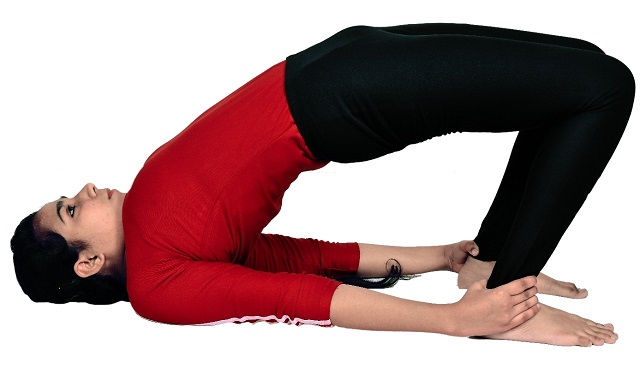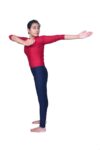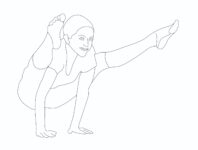Meaning of Bridge pose-Setu Bandhasana
- Bridge pose yoga in Sanskrit is known as Setu Bandhasana.
- It is pronounced as ‘SET-tooBhan-dahs-anna.’
- Setu means dam, dike, or bridge
- Bandha means to lock, bind
- Setubandhasana means forming a bridge or dam
- It looks like a bridge, known as the bridge formation pose.
What is a Setu Bandhasana
- Bridge pose is one of the essential supine yoga poses.
- It is called bridge pose because it resembles a dam in the final stage.
- The yoga asana plays a vital role for the nerves, spine, and muscles on a finer scale, especially of the back region, thus facilitating smooth coordination between the body & mind.
- It is beneficial in treating thyroid, back pain, and neck pain.

Bridge pose introduction
In the article, it has systematically described what bridge pose is, how to do it, and what are its benefits and precautions. All these aspects have been elaborated on and mentioned after in-depth research on Setu Bandhasana. The easily explained steps, uses, precautions, images, and videos of bridge pose- Setu bandhasana will help you to understand the yoga pose technically correctly, thereby extracting maximum benefits from it.
How to do bridge pose procedures step by step
It’s a simple and easy yoga pose with many essential health benefits. Its more straightforward step-by-step technique has been mentioned below.
- Lie down on a flat surface in Shavasana.
- Keep your arms straight beside your thighs.
- Fold your legs and try to clasp your ankles with your palms.
- Maintain a distance of 10 inches between your feet.
- Inhale, raise your back as per one’s flexibility.
- After reaching the final position, maintain the pose as long as possible (initially for 30 seconds). And increase the duration as you become perfect in the practice.
- Do slow inhaling and exhaling while maintaining the pose.
- Exhale; slowly bring your back down.
- This is the one round.
- Do 2-3 rounds.
Breathing
Breathing awareness is one of the essential aspects of practicing the bridge pose. During raising the back, one should inhale. Slow and deep inhaling-exhaling should be continued while maintaining the posture. One should exhale while bringing the backdown.
Muscular movement
Various muscles are experiencing stretching and compressing while performing the yoga pose. Some of the forces that are exposed to movements are the back, legs, knees, chest, thighs, arms, and the muscles of the neck region. For body and mind balance, try to feel finer movement in the muscles and nerves of the back area. The abdominal muscles also experience stretching.
Video of bridge pose
The video will help the practitioners to practice the yogasana correctly.
Video Courtesy: Morarji Desai National Institute of Yoga
Bridge Pose in different schools of yoga
Setu Bandhasana has some variations in steps and techniques performed by renowned yoga experts and teachers. These different techniques by different schools of yoga while practicing Setubandhasana are given below.
- Iyengar yoga: In the Iyengar School of yoga, palms are kept on the raise back. Legs are raised and straight, which are long and big bridges.
- Vinyasa yoga: It is just the technique mentioned above. Here, the hands don’t clasp the ankles; the palms are interlocked and lie on the surface below the hips.
- Ashtanga yoga: It is similar to vinyasa yoga.
- Baba Ramdev yoga: It is similar to the technique mentioned above.
- Art of living: It is similar to vinyasa yoga.
- Power yoga: The main focus is on stretching and rigorous posture.
- Hot yoga: It is similar to power yoga but more strenuous.
- Satyananda yoga: The entire body is uplifted and rested upon soles and palms.
- Bikram yoga: It is similar to Iyengar yoga.
Top 10 health benefits of bridge pose
Some of the essential benefits of Setu Bandhasana are given below.
- Thyroid disorders: If we are discussing bridge pose, the first benefit that comes to mind is the health of the thyroid gland. It gives massage to the gland and ensures the secretion of thyroxin hormone, which in turn treats hypo and hyperthyroidism.
- Back pain is a vital yoga pose for treating back-related issues. Practicing the yoga pose provides suitable stretch to the spine, nerves, and the entire vertebral column, thus helping to relieve backache and pains related to the spine and vertebral column.
- Legs strengthening: It is excellent for maintaining the legs, thighs, hips, and buttocks. It is bone for those who have weak legs and muscles.
- Belly fat: It controls weight as thyroxin hormone ensures weight management. Practicing it correctly and maintaining it for a certain period helps to burn fat from the belly region.
- Practising it correctly and maintaining it for a suitable time helps to burn fat from the belly region.
- Hair loss: Regular pose practice helps to healthy hair. As mentioned above, its proper technique ensures adequate blood and oxygen flow in the scalp region, which is good for hair health.
- Chest congestion: If you encounter chest congestion, it is recommended to practice the asana regularly. It helps increase the lung area and strengthens the bronchia and alveoli.
- Tennis elbow pain: Tennis elbow pain can be minimized by practicing Setu Bandhasana. The yoga pose gives suitable stretch to the elbow region and helps to rejuvenate the muscles and nerves of that region. This stirs the flow of blood and oxygen in that area, thereby giving relief from pain.
- Digestion: It helps to stimulate the secretion of gastric and enzymatic juices, thereby beneficial to indigestion and constipation. It is also suitable for the health of the colon and alimentary canal.
- Depression: The asana works well on the nerves and muscles of the spinal region. If it is practiced from a therapeutic point of view, it shows soothing impacts on the synergy of nerves of the spinal and vertebral columns.
- Facial complexion: It helps fresh and rejuvenate the facial region’s cells and tissues by supplying blood, oxygen, and nutrients.
Bridge pose precautions
Some of the few contraindications/cautions/limitations of Setu Bandhasana are:
- Acute knee pain
- Back injury
- Severe neck pain
- Shoulder injury
- Elbow injury
- The Head shouldn’t be moved while performing the pose.
Beginner’s tip
This yoga pose doesn’t require a high level of flexibility. But, it is better to perform the asana with technique. Initially, the beginners should try to raise their back as per their flexibility. But raising the back to the recommended level has become easy if you clasp your ankles.
Preparatory pose
- Tadasana
- Stickasana
- Bhujangasana
- UrdhvaMukhaSvanasana
- Virasana
Follow-up / counterpose
- Bhujangasana
- Shalbhasana
- Urdhva Dhanurasana
- Pawanmuktasana
Points to remember
- Knees should be in line with hips
- Pelvis and chest lift up
- The feet should be pressed evenly.
- Fingers are interlocked, and palms are pressed on the surface.
- The side of the upper arms should be on the mat.
- The back of the neck should be on the mat.
The science behind bridge pose
Though it’s a simple back-lying yoga practice, its anatomy and physiology are paramount to harnessing its benefits. The muscles which are prominently involved during the asana are:
- Rectus abdominis
- Quadriceps
- Hamstrings
- Gluteus maximus
- Triceps brachii
- Brachialis
- Posterior deltoid
- Bicep brachii
Modification and variations
- Setubandha Sarvangasana
- Supported bridge pose
- Ekapada setubandhasana
- Seated Half spinal twist pose






